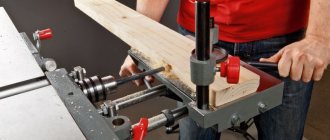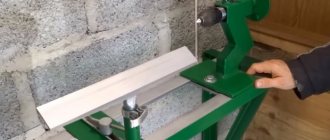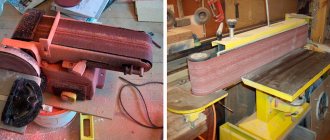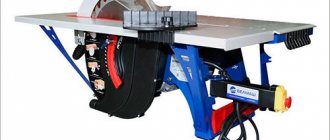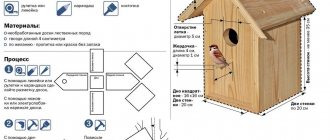Wood is easy to process. Using simple tools, you can create things of amazing beauty and functionality.
Separately, it is worth noting products that have the shape of rotation figures: tool handles, staircase balusters, kitchen utensils. To make them, an ax or chisel is not enough; you need a lathe.
Buying such a device is not a problem, but a good machine is expensive. It’s not difficult to acquire such a useful tool and save money, because you can make a wood lathe with your own hands.
Features of wood lathes
In a number of cases, a hardworking owner has a desire to make furnishings and utensils that have a circular cross-section throughout their entire length.
Most often these things are:
- Holders for hammers and files;
- Stair posts, flowerpots, handles for railings;
- Rolling pins, potato presses, grape crushers;
- Vertical pencil cases;
- Cups, mugs, saucers, plates, trays, stoppers.
It will be impossible to cut such things with planes and saws. In this case, you will need at least the most primitive machine.
Buying a lathe
Today you can purchase such a device with a click of the mouse by going to a specialized online store. True, such a purchase will hurt your pocket, especially if you choose a high-quality model and not a cheap Chinese craft.
However, this does not mean that the idea of founding a miniature workshop will have to be given up. The problem of high cost can be solved by taking a different route. A simple and durable electrical unit must be made by hand.
Turning round architectural decorations
Such a mechanism will be an excellent help if you need to make inexpensive repairs to a cottage equipped with
- Flights of stairs with wooden balustrades;
- Decorative trims;
- Carved shutters;
- Window earrings.
Important indicators of turning equipment
Mini-machines designed for wood processing have a whole set of important parameters that you should know and take into account when choosing this equipment.
Power - it talks about the performance of a particular model, and also indicates the amount of electricity consumed by the equipment during its operation. For mini-lathes for desktop use, this figure is 350 W.
Spindle rotation speed - this parameter largely depends on the accuracy of material processing and its hardness. The rotation speed of modern models of woodworking machines varies from 400 to 3500 rpm.
Along with the parameters listed above, the cost of turning equipment for domestic use is no less important. Currently, the market offers a large selection of machines for household use, so every home craftsman can choose equipment that is suitable for price and functionality. When choosing a lathe, you should consider not only the price, but also the quality of the equipment.
Profitable and promising business
Having gained some experience in the production of decor, it will be possible to move from banal savings to a profitable business. This could be the production and sale of chess pieces. If you sell them through online auctions or retail chains, then an additional source of income will appear in the family budget.
Handmade items quickly find demand, especially if they are offered for sale at a reasonable price.
In the future, this hobby will develop into full-time commercial employment, giving you a chance to acquire professional tools and start earning very good money.
Main components
The most important components of such a device include
- Bed;
- Electric drive;
- Front and back headstock;
- Stand for accessories.
Support frame base
The bed is a frame that allows you to connect all the parts into a harmonious mechanism. The strength and reliability of such a support directly determines the stability and durability of the entire device. It is better and easier to use a steel angle to make the frame; another suitable material is a rectangular profile.
First of all, it is necessary to mark the dimensions of the assembled automatic sharpening machine. These parameters are determined by what exactly this machine will be used for. As a rule, a stand for an apartment or garage modification does not exceed eighty centimeters in length.
Frame manufacturing process
The slats selected for assembling the frame must be laid so that their upper edges are strictly in the same plane. The parallelism of these guides is checked by measuring the distances between their ends on each side.
- Longitudinal fragments are secured with clamps. The transverse parts are made from the same profile.
- There will be three crossbars in total. Two of them are fixed at the edges of the device, and the third is placed a couple of tens of centimeters from the left end.
At the next stage, all components are joined by welding into a solid composition. It is important that the resulting connecting joint is strong and smooth.
Design and principle of operation
All components and parts of the lathe are located on the frame or bed. The main design elements: a front support with a drive and a transmission shaft, a rear support for fixing the part and a mobile stand for the cutter. The headstock contains a driving chuck, which transmits rotational motion to the workpiece. The tailstock holds the free end of the workpiece; it is especially necessary when working with long parts. A cutter stand or support supports the cutter in the right place.
The workpiece is fixed in a lathe between the centers of supports or on a faceplate. When working with wood blanks, the first method is most often used, which does not allow processing the ends. Mounting on a faceplate is used when processing end surfaces; it is more reliable. The part is secured using bolts rather than chuck teeth.
When fastening, it is important to center the part so that it does not “beat” during movement. For this purpose, an angular type center finder is provided.
The cutter is fed manually; it is fixed only when working with a copier. In other cases, the master holds the cutter with his own hands with emphasis on the thrust bearing.
The workpiece is turned in two passes:
- rough: at an angle of up to 30 degrees;
- final: at an angle of up to 45 degrees.
For each pass, material no more than 1 millimeter thick is removed.
When choosing a lathe for home use, you should pay attention to the amount of spindle runout. A very good result is 0.02 mm, because working with wood processing equipment with your own hands does not imply perfect accuracy.
Selecting an Electric Powertrain
When choosing a motor to power the turning system, it is necessary to clarify how powerful it is. For the construction of a homemade self-heating unit, an indicator in the range of 1.2 - 2 kW is quite sufficient. In this case, you should find out exactly what scheme the connection is made according to.
For desktop woodworking, a motor from a household centrifuge is sufficient. Although he is not able to provide turning of a massive workpiece, he will definitely master the processing
- Miniature souvenirs;
- Kitchenware;
- Various types of furniture accessories.
Specifications
If you are planning to purchase a machine for your home workshop, then you should pay special attention to such a criterion as its power. The tasks that the device must perform depend on the power. Sometimes it happens that a table saw is the best choice, since all the products do not require huge labor costs. But if you are planning to open a small business, then for this business you need a machine with a power of more than 500 kW.
But the choice should also depend on the size of the part that the machine can process. For correct sampling according to this criterion, only two parameters need to be taken into account. The first is the distance from the part to the frame, most often it is in the range of 25–40 cm. The second is the center-to-center distance, from 33 to 110 cm.
After the first two, in terms of importance and count, characteristics, you need to move on to the third - spindle speed. Since the range of choice is very wide, you should start from the general rule created on the basis of the following correlation - the cleanliness and accuracy of processing depends on the speed of rotation of the workpiece.
If you choose a home machine, then special attention should be paid to the spindle runout. An excellent result is considered to be two hundredths of a mm, since working on such a machine does not imply ideal results.
Lathe spindle
However, if the indicator is significantly higher, you should abandon such a purchase in favor of a more accurate device.
Functional front lock
For figured turning, the workpiece is fixed between two clamps, which are usually called headstocks. At the same time, torque from the electric motor is transmitted to the front, and therefore it will be somewhat more difficult to assemble it.
The front clamp of a home lathe is an iron U-shaped structure, between the sides of which a shaft and a pulley system are mounted on bearings. The body is assembled from thick rolled steel segments.
Why is it needed and how does it work?
A lathe is designed for the manufacture of wooden products that have a cylindrical or similar shape. This is an indispensable thing when renovating a country house with a wooden staircase, a carved porch, but not only.
If you have some experience, a turning tool will allow you not only to save on purchased decorative elements, but also to earn money, because handmade wooden products are highly valued.
Whether such a machine is needed in a home workshop is up to the master to decide.
Of course, if you need several handles for chisels, it is easier to buy them, but if you want to make an all-wood staircase, then a set of balusters will cost a very large sum. It is much cheaper to make them yourself. By the way, you don’t even have to spend money on buying equipment - a simple machine can be made in your own workshop using scrap materials.
The operating principle of a wood lathe is not particularly complicated. The cylindrical workpiece is fixed along the axis of rotation. Torque is transmitted to it. By bringing various cutters or grinding tools to the workpiece, it is given the desired shape.
Main parts of lathe:
- a frame on which all components are fixed;
- electric drive;
- headstock;
- tailstock;
- handyman
For ease of operation, schemes for changing the rotation speed are used. In professional equipment, this is a real gearbox, a system of gears that allows you to regulate speed within a very wide range. This is difficult; it is enough to equip a homemade wood lathe with a belt drive with several pulleys of different diameters.
Installation of the second clamp
The purpose of the rear analogue is to support the conditional cylinder to be sharpened and provide it with freedom for rapid rotation. The more firmly the tailstock holds the workpiece, the better the final result will be.
- An indispensable condition for proper installation of the second clamp is maintaining alignment with the first.
- Faced with great difficulties at this stage, it makes sense to significantly simplify the task by purchasing a completely finished unit.
The use of an electric drill chuck will allow you to significantly modify the engineering solution. A shaft is clamped in it, the end of which must be pointed.
Mini machine for small jobs
Often there is a need to turn several small wooden parts, in this case it is not at all necessary to make a full-fledged machine; you can get by with a mini-wood lathe. Its production does not require much labor and will not take much time.
The design of such a machine is extremely simple. A motor from an old tape recorder, powered from an external power supply, is ideal as an electrical component. The bed of the mini-machine will be a piece of board of the required length.
The engine must be secured. Of course, a belt drive is not suitable for a small machine; the workpiece will have to be mounted on the motor shaft. The best device for this is a faceplate. The drive housing is a U-shaped plate, in the center of which a hole is drilled for the shaft. The engine in the housing is mounted on the frame using self-tapping screws.
The main part of the machine is ready, all that remains is to make the tailstock. Its body is made of a block of suitable size. A hole for the shaft is drilled in it exactly at the height of the engine; a dowel-nail of suitable length is used as it. The headstock is attached with glue and several screws.
Using a power source with the ability to adjust the output voltage, you can create a machine with variable rotation speed. It is convenient to regulate the speed using the foot control pedal. The design of this device can be very diverse, it all depends on the available parts.
Convenient turntable
All that remains is to make a tool rest, where needle files, jigsaws, sandpaper, planes and hacksaws will be laid out during work. Its outlines are not regulated in any way, but it must be completely comfortable.
It is better to design such a table with the participation of the master who will become the main user of the automatic sharpener.
The best option is a swivel stand in the shape of a trapezoid. It is cut out of a thick iron sheet, after which it is mounted on a rotary hinge with a large two-way angle. It will be easy to move such a table in order to bring files closer to you or move them away for a while.
Review of the most popular models
wood lathe Jet-1442
Let's look at the characteristics of several models of lathes for amateur use.
| Kinzo 48P5600 | Proxxon DB250 | Jet JML-1014i | Caliber STD-350 | Corvette 71 | |
| Type | desktop | desktop | desktop | desktop | desktop |
| Power, W | 350 | 100 | 370 | 350 | 370 |
| Electric motor type | asynchronous | collector | collector | collector | asynchronous |
| Rotation speed, rpm | 850 — 2150 | 1000-5000 | 500 — 3900 | 500 — 3400 | 760 — 3200 |
| Maximum workpiece dimensions | 1000 x 350 | 250 x 80 | 350 x 250 | 330 x 250 | 420 x 250 |
| Spindle size | 1 x 8″ | M16x1 | 1 x 8″ | 1 x 8″ | 1 x 8″ |
| Weight, kg | 38 | 2 | 30 | 17,5 | 38 |
Table 1. Technical characteristics of lathes for home
Kinzo 48P5600: the bed is made of rectangular pipes, it is possible to use an extension for processing workpieces longer than 40 cm. You can change the speed of rotation of the workpiece by rearranging the belt on the pulleys (4 pairs). When purchasing such a machine, you should pay attention to the alignment of the front and rear axles. When pressed by the rear stand, the base may become deformed. Fragile plastic handles with clamping bolts.
Jet JML-1014i: solid cast iron frame. The rotation speed changes smoothly in several ranges. To change the range, you need to move the belt on the pulley. It works very quietly, it is convenient to set the speed on the electronic unit. To lock the spindle, a push handle is provided, which is located on the left.
Proxxon DB250: aluminum frame, very small in size, allows you to turn only the smallest parts for aircraft modeling. During operation, it is advisable to attach the device to a workbench, otherwise the light alloy structure will dangle. It works very quietly, there is no beating, but the power of the machine is low, so you need to work carefully and slowly.
Corvette 71: cast iron frame, rotation speed is changed by rearranging the belt pulleys. Despite its small size, the design is no different from professional turning equipment. The engine maintains stable speeds, practically does not vibrate and makes no noise. The tool rest is short, it is clearly not enough for internal turning of parts longer than 110 mm. Equipped with a convenient eccentric mechanism for rearranging the tool rest.
Caliber STD-350: neat frame made of cast iron. The center of the rear and front axles may not coincide, which is very difficult when working with short parts made of dense wood. The spindle does not hit, it is easy to adjust, the frame is durable, and it works quietly. Weak frequency regulator - torque at the minimum position is almost impossible to use.
Cutters of different calibers
Cutting attachments are sold in every major hardware supermarket. At the same time, it is possible to buy both single cutting parts and sets.
With a wide selection of cutters available, the turner will create any complex and intricate configurations, including
- Grooves;
- Chamfers;
- Cones;
- Dashed lines;
- Edging;
- Wavy lines.

